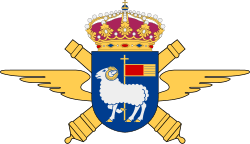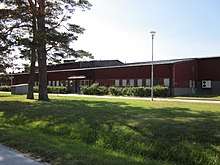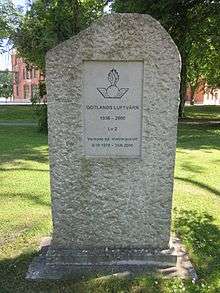Gotland Anti-Aircraft Corps
| Gotland Anti-Aircraft Corps | |
|---|---|
| Gotlands luftvärnskår | |
 | |
| Active | 1944–2000 |
| Country |
|
| Allegiance | Swedish Armed Forces |
| Branch | Swedish Army |
| Type | Anti-aircraft corps |
| Size | Corps |
| Part of |
Lv 3 (1944–1953) Lv 2 (1953–1963) MKG (1963–1993) Milo M/MKG (1993–2000) |
| Garrison/HQ | Visby |
| Motto(s) |
Fecimus Facimus Faciemus ("We've done it - We do it - We shall do it") |
| Colors | Red, later orange |
| March | "Gotlands luftvärnskårs marsch" (Rösell)[1] |
Gotland Anti-Aircraft Corps (Swedish: Gotlands luftvärnskår), also Lv 2, was a Swedish Army Anti-aircraft unit that was active in various forms between 1944–2000. The unit was based in Visby on Gotland.[2][3]
History
Gotland's air defence has its origins in the Stockholm Anti-Aircraft Regiment's (Lv 3) artillery battery detachment on Gotland (Lv 3 G), established in 1944. When Stockholm Anti-Aircraft Regiment moved to Norrtälje in 1953, the responsibility for the artillery battery on Gotland was transferred to Östgöta Anti-Aircraft Regiment (Lv 2) in Linköping and thus the unit received the designation Lv 2 G. Östgöta Anti-Aircraft Regiment was disbanded in 1962. Lv 2 G took over its ensign and traditions on 2 April. On 1 April 1963, Lv 2 G became the new Lv 2. On 1 July 1968, the term "division" was changed to battalion. Lv 2 was then named Royal Gotland Anti-Aircraft Battalion. In 1969, the battalion received the heat-seeking anti-aircraft missile FIM-43 Redeye and could begin training.[4]
In October 1978, Lv 2's basic training battalion moved from Korsbetningen (A 7's area) to Visborgsslätt, while the management for Lv 2, personnel and staff department, planning and production department and the artillery, simulation, fire-control system buildings remained at Korsbetningen. Every day from October 1978 to May 1986, the conscripts were transported between Visborgsslätt and Korsbetningen to be trained in their main service. In March 1983, the management moved from its old staff barracks at Korsbetningen to newly renovated premises in the top floor of the Chancellery building at Visborgsslätt. During the spring of 1986, Lv 2 could gradually settle in the newly built artillery/anti-aircraft building at Visborgsslätt. On 24 May 1986, Lv 2 officially moved from Korsbetningen to Visborgsslätt. At the same time, Lv 2 celebrated 50 years of air defense training on Gotland.
Through a reorganization of the Gotland Anti-Aircraft Battalion in 1994, the Gotland Anti-Aircraft Corps (Lv 2) was formed. The corps was disbanded on 31 August 2000 by previous decisions in the Defence Act of 2000.
Locations and training areas

On 1 April 1944, the anti-aircraft defense on Gotland was transferred from the Coastal Artillery to Stockholm Anti-Aircraft Regiment (Lv 3), which formed the detachment Stockholm Anti-Aircraft Regiment's Battery on Gotland (Lv 3 G). The detachment was placed in a barracks camp by Söderväg in southwest Visby. In 1945, detachment moved into barracks 2 and 3, which were built the same year at Gotland Artillery Corps (A 7) barracks area at Östra Hansegatan. From 1 November 1952, the detachment was transferred to Östgöta Anti-Aircraft Regiment (Lv 2). From 1978, the conscript training was transferred to Gotland Regiment's (P 18) barracks area in southern Visby, where also the staff was moved on 17 March 1983.[5]
Heraldry and traditions
On 6 June 1941, the Chief of the Army Ivar Holmquist presented the colours to Östgöta Anti-Aircraft Regiment, which was carried by the regiment until 31 March 1962. The colours was then transferred to the Gotland battery, which at the same time was reorganized into an independent unit under the name of Gotland Anti-Aircraft Division (Lv 2), who came to carry the colours on certain occasions. Gotland Anti-Aircraft Division also took over the regiment traditions, and continued them until 31 August 2000. From 1 September 2000, the Air Defence Regiment (Lv 6) retains the memory of all disbanded anti-aircraft units.[2]
In 1963, the colours was presented to Gotland Anti-Aircraft Division by the Chief of the Army, Lieutenant General Curt Göransson. In 1990, the Gotlands luftvärnsbataljon hedersmedalj ("Gotland Anti-Aircraft Battalion Honorary Medal") in gold (GotlvbatGM) was established, and when Gotland Anti-Aircraft Corps was disbanded in 2000, the Gotlands luftvärnskår minnesmedalj ("Gotland Anti-Aircraft Corps Commemorative Medal") in silver (GotlvkMM) was established.[2]
 Gotland Anti-Aircraft Battalion Honorary Medal in Gold, m/1990.
Gotland Anti-Aircraft Battalion Honorary Medal in Gold, m/1990. Gotland Anti-Aircraft Corps Commemorative Medal in Silver, m/2000.
Gotland Anti-Aircraft Corps Commemorative Medal in Silver, m/2000.
Commanding officers

Commanding officers active at Lv 2:[6]
- 1944–1948: Cpt Ewald Fock
- 1948–1952: Cpt Lars Falk
- 1952–1954: Cpt Lars Falk
- 1954–1957: Ltc Gunnar Almqvist
- 1957–1961: Ltc Lars Erik Lidsjö
- 1961–1963: Ltc Uno Engström
- 1963–1968: Ltc Uno Engström
- 1968–1972: Ltc Uno Engström
- 1972–1976: Ltc Per-Olof Martin
- 1976–1981: Ltc Lars Brunnberg
- 1981–1989: Ltc Hans Ahldén
- 1989–1992: Ltc Gunnar Jansson
- 1992–1994: Ltc Benkt Kullgard
- 1994–1997: Ltc Benkt Kullgard
- 1997–1999: Ltc Kent Samuelsson
- 1999–2000: Ltc Göran Wahlqvist
Names, locations and designations
| Kungl Stockholms luftvärnsregementes batteri på Gotland | Royal Stockholm Anti-Aircraft Regiment's Battery on Gotland | 1944 | – | 1952 |
| Kungl Östgötas luftvärnsregementes batteri på Gotland | Royal Östgöta Anti-Aircraft Regiment's Battery on Gotland | 1952 | – | 1961 |
| Kungl Östgötas luftvärnsregementes division på Gotland | Royal Östgöta Anti-Aircraft Regiment's Division on Gotland | 1961 | – | 1963 |
| Kungl Gotlands luftvärnsdivision | Royal Gotland Anti-Aircraft Division | 1963 | – | 1968 |
| Kungl Gotlands luftvärnsbataljon | Royal Gotland Anti-Aircraft Battalion | 1968 | – | 1974 |
| Gotlands luftvärnsbataljon | Gotland Anti-Aircraft Battalion | 1975 | – | 1994 |
| Gotlands luftvärnskår | Gotland Anti-Aircraft Corps | 1994 | – | 2000 |
| Norra Hällarna, Visby (F) | 1944 | – | 1945 |
| Korsbetningen, Visby (F) | 1945 | – | 1978 |
| Visborgsslätt, Visby (F) | 1978 | – | 2000 |
| Lv 3 G | 1944 | – | 1952 |
| Lv 2 G | 1952 | – | 1963 |
| Lv 2 | 1963 | – | 2000 |
References
Notes
- ↑ Sandberg 2007, p. 201
- 1 2 3 Braunstein 2005, pp. 229–230
- ↑ Kjellander 2003, p. 264
- ↑ Hammarhjelm 1999, p. 227
- ↑ Holmberg 1993, p. 33
- ↑ Olsson, Kjell. "Förbandschefer 1944 - 2000". www.tjelvar.se (in Swedish). Gotlands militärhistoria & Gotlands trupper. Retrieved 6 December 2017.
- Braunstein, Christian (2003). Sveriges arméförband under 1900-talet. Skrift / Statens försvarshistoriska museer, 1101-7023 ; 5. Stockholm: Statens försvarshistoriska museer. ISBN 91-971584-4-5. LIBRIS 8902928.
- Hammarhjelm, Bengt (1999). Beredskap på Gotland 175 år: 1811-1986 (in Swedish) (2nd, ext., plus complementary to 2000 ed.). Visby: Ödin. ISBN 91-85716-84-7. LIBRIS 7751982.
- Holmberg, Björn (1993). Arméns regementen, skolor och staber: [en uppslagsbok] : en sammanställning (in Swedish). Arvidsjaur: Svenskt militärhistoriskt bibliotek (SMB). ISBN 91-972209-0-6. LIBRIS 7796532.
- Kjellander, Rune (2003). Sveriges regementschefer 1700-2000: chefsbiografier och förbandsöversikter (in Swedish). Stockholm: Probus. ISBN 91-87184-74-5. LIBRIS 8981272.
- Sandberg, Bo (2007). Försvarets marscher och signaler förr och nu: marscher antagna av svenska militära förband, skolor och staber samt igenkännings-, tjänstgörings- och exercissignaler (in Swedish) (New ed.). Stockholm: Militärmusiksamfundet med Svenskt marscharkiv. ISBN 978-91-631-8699-8. LIBRIS 10413065.
Further reading
| Wikimedia Commons has media related to Gotland Anti-Aircraft Corps. |
- Edwards, Rutger; Hellström, Göran, eds. (2004). Gotlands arméluftvärn och Lv 2: 1936-2000. Visby: Lv 2 kamratfören. [distributör]. ISBN 91-631-5042-5. LIBRIS 9499917.
- Rosén, Lars, ed. (1994). Gotländskt arméluftvärn: "från batteri till kår på 50 år". Visby: Gotlands luftvärnskår. ISBN 91-630-2609-0. LIBRIS 7450031.
External links
- Lv 2 Kamratförening (in Swedish)